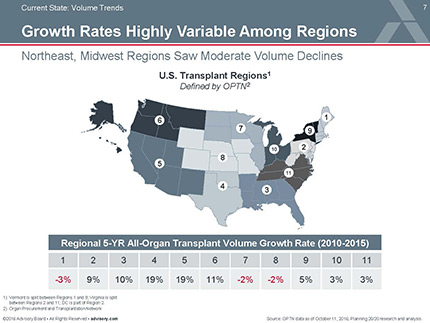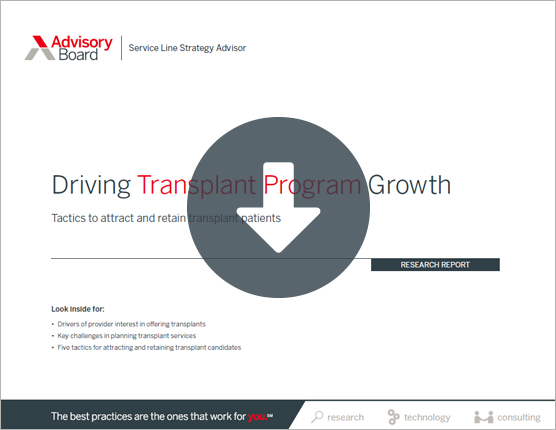Auto logout in seconds.
Continue LogoutEditor's note: This popular story from the Daily Briefing's archives was republished on May 6, 2020.
When 19-year-old Aliana Deveza learned that her dying mother's chances of finding a kidney donor were slim, she came up with a risky idea that saved both her mother's and another patient's life—and could change the way transplant centers conduct donations in the future, Lenny Bernstein reports for the Washington Post.
Here are 5 key tactics to attract and retain transplant patients
Running out of time
In 2015, Aliana's mother, Erosalyn Deveza, was close to death. Her kidneys were failing, and she spent every night attached to a home dialysis machine.
Doctors told Deveza a kidney transplant was the only treatment option that would save her life, but her blood relatives were also at risk for the disease and so couldn't safely donate a kidney, and her non-blood relatives and friends weren't a match.
Without a living donor, doctors determined it was unlikely Deveza would receive an organ transplant in time to save her life, Bernstein reports.
A bright idea
So in 2015, Aliana turned to the web to find a solution and help her mother get a transplant.
Aliana stumbled upon a paper by John Dickerson, who's now an assistant professor at University of Maryland, that discussed "multi-organ exchange."
The idea builds on the existing practice of "live, paired donation," in which a live donor is not a match for their intended recipient but is willing to instead donate their organ to a different patient, Bernstein reports. In exchange, that recipient finds a second donor who matches the original donor's intended recipient—essentially trading one donation for another. The term "chain" is used when the pool of donors and recipients widens beyond two pairs.
Dickerson's paper sought to build on that approach by developing a model for multi-organ transplants, in which not only kidneys but other organs as well could be swapped as part of paired donations. Dickerson said his research shows that "in theory you increase the number of transplants by … 25 to 30%."
The first multi-organ transplant
The research gave Aliana an idea: Although she wasn't medically eligible to donate her kidney, perhaps she could donate part of her liver to someone else and, in return, secure a kidney for her mother.
"I was actually just looking at other types of transplant procedures that are done," Aliana said. "If I can't donate my kidney, what other thing could I donate so my mom could get a kidney?"
Aliana called multiple transplant hospitals, asking if she could donate her liver to an organ recipient in exchange for a kidney for her mother. What she didn't know at the time was that Dickerson's multi-organ exchange plan was just a model and that a liver-kidney swap had never been performed before, Bernstein reports.
"Nobody knew what I was talking about. They didn't know which department to transfer me to," Aliana said. "One hospital I talked to wanted to transfer me to the morgue."
Eventually, Aliana emailed John Roberts, a transplant doctor who runs the liver transplant program at the University of California at San Francisco (UCSF). Roberts thought the idea was "brilliant."
Roberts brought Aliana in for testing and, over a year later, they found a match in 49-year-old Annie Simmons, who was willing to donate her kidney in exchange for a liver for her sister, Connie Saragoza de Salinas.
There was one more hurdle. They had to get approval from the hospital's ethics committee, as liver transplants are far riskier for the donor than kidney transplants.
But the committee eventually signed off, and on July 20, 2017, Roberts implanted part of Aliana's liver into Saragoza de Salinas, while Erosalyn Deveza received Annie Simmons' left kidney. The chain of events made up the first-ever liver-kidney swap, Bernstein reports.
Although Saragoza de Salinas had life-threatening complications after the surgery, according to Simmons and Roberts, she has since recovered well. Erosalyn Deveza has made a full recovery and is now working full time.
As for the historic exchange, Roberts said he and the other surgeons "got showed up by a 19-year-old." He added, "She thought of it. I didn't."
The future of multiple organ transplants
Since the surgery, UCSF has tried to arrange other live-kidney exchanges without success. According to UNOS, there has not been another liver-kidney swap since the Deveza case.
But Erosalyn Deveza hopes the success of her transplant will give way to similar arrangements and save more lives. "This is what we want, to make this like a program," she said. "I believe it will help a lot of people and maybe shorten the [wait] list" (Bernstein, Washington Post, 5/11; Dickerson/Sandholm, Journal of Artificial Intelligence Research, 11/26/17).
Here are 5 key tactics to attract and retain transplant patients
Download this briefing to learn how to expand the pipeline of potential transplant patients and engage them across the care pathway.
Don't miss out on the latest Advisory Board insights
Create your free account to access 1 resource, including the latest research and webinars.
Want access without creating an account?
You have 1 free members-only resource remaining this month.
1 free members-only resources remaining
1 free members-only resources remaining
You've reached your limit of free insights
Become a member to access all of Advisory Board's resources, events, and experts
Never miss out on the latest innovative health care content tailored to you.
Benefits include:
You've reached your limit of free insights
Become a member to access all of Advisory Board's resources, events, and experts
Never miss out on the latest innovative health care content tailored to you.
Benefits include:
This content is available through your Curated Research partnership with Advisory Board. Click on ‘view this resource’ to read the full piece
Email ask@advisory.com to learn more
Click on ‘Become a Member’ to learn about the benefits of a Full-Access partnership with Advisory Board
Never miss out on the latest innovative health care content tailored to you.
Benefits Include:
This is for members only. Learn more.
Click on ‘Become a Member’ to learn about the benefits of a Full-Access partnership with Advisory Board
Never miss out on the latest innovative health care content tailored to you.


